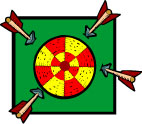 I once got a call from a woman who wanted some PowerPoint advice. She said something along the lines of, “Well, I’ve finished all the slides, now I need to work on my script.” “You fool!” I wanted to shout. “You’ve done it backwards! Throw it away and start all over again!” Then I pictured myself throwing her laptop across the room, adjusting my beret, and storming out as she gazed in stunned silence at her ruined computer.
I once got a call from a woman who wanted some PowerPoint advice. She said something along the lines of, “Well, I’ve finished all the slides, now I need to work on my script.” “You fool!” I wanted to shout. “You’ve done it backwards! Throw it away and start all over again!” Then I pictured myself throwing her laptop across the room, adjusting my beret, and storming out as she gazed in stunned silence at her ruined computer.
Well, imaginary artistic hissy fit aside, I did tell her that she was doing things backwards. Most creative endeavors start with rough drafts and/or sketches. You use these to build a solid idea then work through a number of changes before arriving at a finished product. Think of an artist’s sketchbook, a reporter scribbling notes, a photographer taking test shots with a portable phone, or a songwriter noodling around on a piano trying out different melodies.
“What does this have to do with PowerPoint?” you’re probably wondering. It has everything to do with PowerPoint, because with forethought, planning, and creativity you can make each deck a strong part of your company’s marketing mix. If you start from the ground up, you can make decks that do a better job of communicating your messages. If you start with the design first and develop the message afterwards, then to quote Foghorn Leghorn, “You’re doin’ it all wrong, boy!”
Start with an outline
An outline is a great tool for getting your thoughts in order, organizing them into a logical progression, and exploring ideas. It’s how I started every paper I ever wrote for school, and it’s how I start all of my PowerPoint presentations to this day. You can create the outline right in PowerPoint, either in the Outline view or right on the slide.
All of what you’re trying to say — the facts, your story arc, examples, whatever — goes into the outline. Think of the outline as the core dump of your brain.
Now, a lot of folks do that then say “Done!”, slap their laptops shut, and call it a day. Wrong wrong WRONG!
Now do the visuals
The outline is only the beginning. You don’t want to be the schlub who reads bullet point after bullet point to an increasingly bored audience, do you? Of course you don’t!
The outline goes into the Speaker Notes so that you can reference it to keep on script, but the slide is where the magic happens. The slide is where you add the photos, graphics, words, video, and charts that support your message.
Use the slide to do what words cannot. Choose images instead of descriptions, videos instead of still photography, graphs instead of tables, brief sentences instead of paragraphs.
And don’t forget that you as a presenter will be there to guide your audience along the path of knowledge that you lay out. Whether you are presenting live, using cloud technology like Brainshark, or conducting a webinar, you yourself are a very important part of your presentation. You are there to tell the audience what you want them to know; the PowerPoint deck supports you, not the other way around.
I don’t know if that woman took my advice. It must have seemed harsh since she’d spent so much time on the slides by the time she called me. I wish she’d called me at the very beginning so that I could have spared her hours of work. But at least she gave me the idea to write this post so that I could help you!
Your turn
Do you use an outline to form your presentation ideas? If not, what method do you use?
